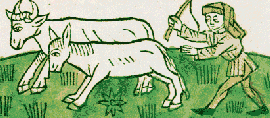Meet the Middle Ages
BackFarming

During the Middle Ages most people were farmers. Many of them owned their farms. Priests, town-dwellers and noblemen also owned land and cattle. To most peasants, most of their work was growing crops and tending live-stock. However, there were regions where the peasants worked in the forests and fished as well.
The members of a peasant family were: the peasant, his wife, and three or four children. If the farm was prosperous, there was also a farm-hand or a servant. There were animals on the farm: oxen, cows, sheep, goats, pigs, hens and geese. The oxen were draught-animals, for example when ploughing. The cows, sheep and goats were milked. People wove cloth from the sheep ´s wool. The hens laid eggs. Some animals were slaughtered in autumn, for their meat.
The most common kinds of crops were rye and barley. It was used for making bread and porridge. Beer was brewed from barley. One grew vegetables such as turnips, cabbage, onions, peas and beans. Flax was grown on many farms, to make linen.
The peasant’s wife took care of most tasks in and around the farm-house, such as churning, spinning and weaving. The farmer did most of the work in the fields, like ploughing, sowing, and cutting down trees in the forest. When the children were old enough they helped their parents, doing simple tasks. The whole family helped each other during harvest, hay-making and slaughter.
In a village it both necessary and taken for granted that the farms would co-operate.
In Denmark and in southern Sweden and Finland, all farmland belonging to a village was gathered in two or three sectors. Within every sector, each farm had one strip or more of cultivated ground. On one of the sectors, the cattle grazed. In this way, the field was fertilised to give better crops the following year.